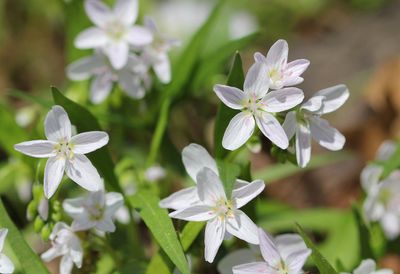About Claytonia Spring Beauty
Spring beauty is a perennial spring flower native to the Midwest. It grows naturally in the woodlands of Ohio, Michigan, Indiana, Illinois, Wisconsin, Indiana, and Missouri. They spread by tubers that are actually edible and were eaten by early pioneers, but growing Claytonia tubers for food is not very efficient—they are small and time-consuming to collect. Claytonia flowering typically begins in April, but this depends on the location and weather. It grows about 3 to 6 inches (8-15 cm.) tall and produces small, star-shaped blooms that are white to pink with pink veins. Spring beauty is a pretty, delicate wildflower that brightens up spring gardens. The flowers open up in sunny weather and stay closed on cloudy days. If you live in spring beauty’s range, look for it as a sign that spring has arrived, but also consider using it as a cultivated garden element.
How to Care for Spring Beauty Flowers
Claytonia spring beauty prefers rich, moist soil. To grow these flowers in your garden or naturalized area, plant the tubers, or corms, in the fall. Space them about 3 inches (8 cm.) apart and deep. Spring beauty prefers dappled sunlight and partial shade, but it will tolerate full sun. A forested area is best for growing, but as long as you water them adequately, these plants will grow in a sunny bed. You can also use Claytonia as an integrated part of a lawn, like crocuses and other early spring bulbs. In a shady area where grass is difficult to grow, these flowers make a nice component of groundcover. Don’t rely on it solely to cover an area, though, as the foliage will die back in summer. Expect your spring beauty to come back every year and to spread. In optimal conditions, it can take over areas of the ground, so take care when selecting where and how you plant these flowers.
